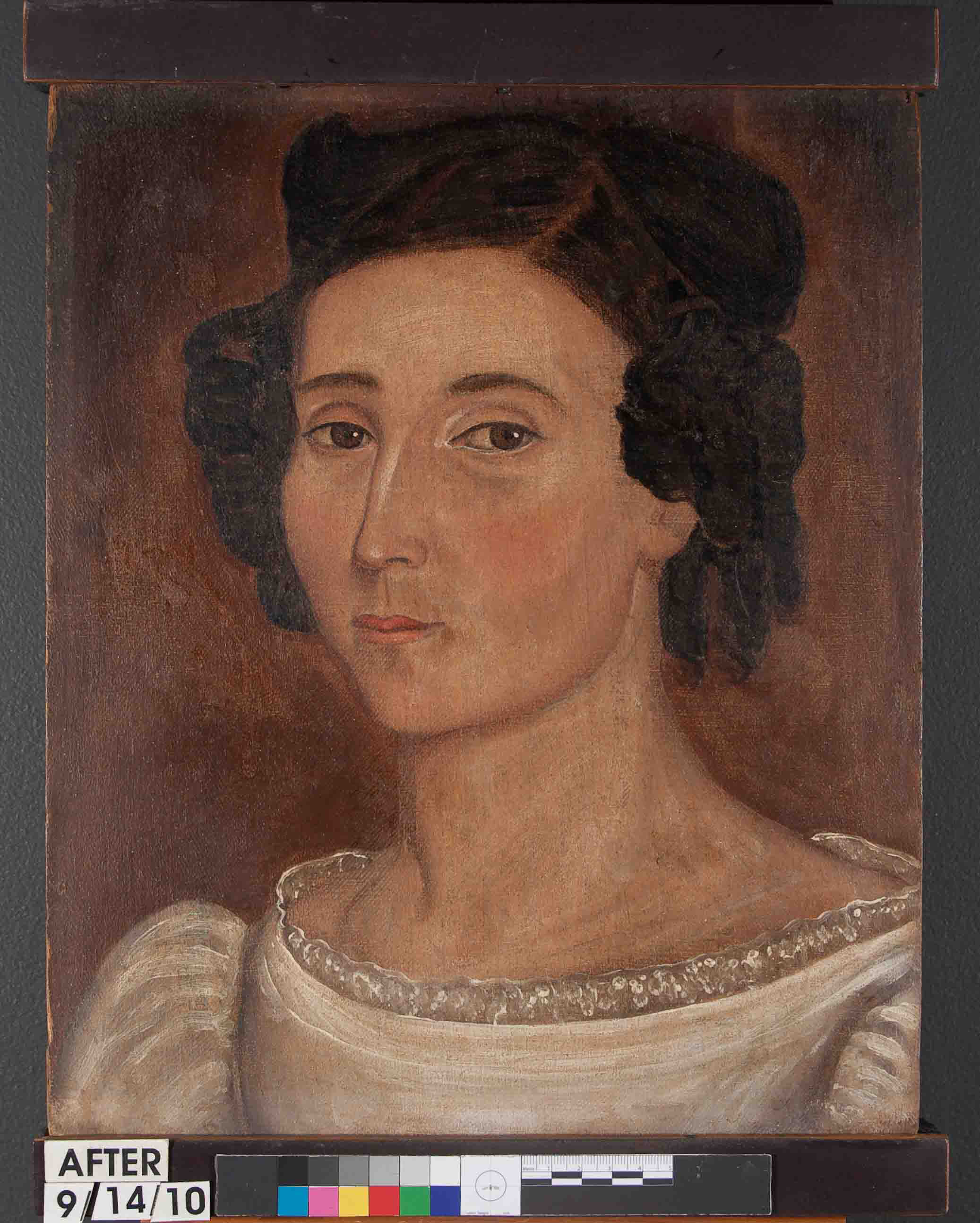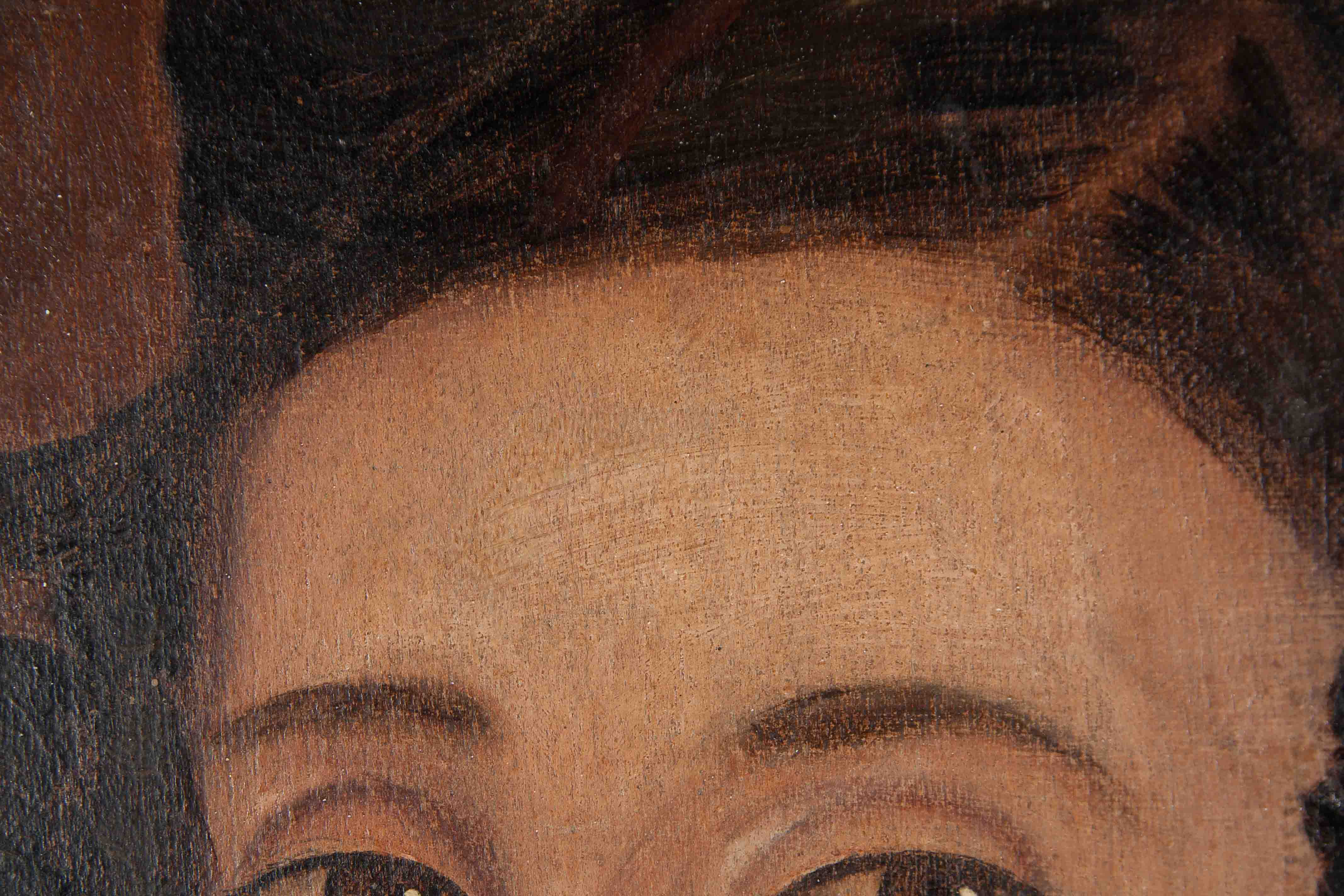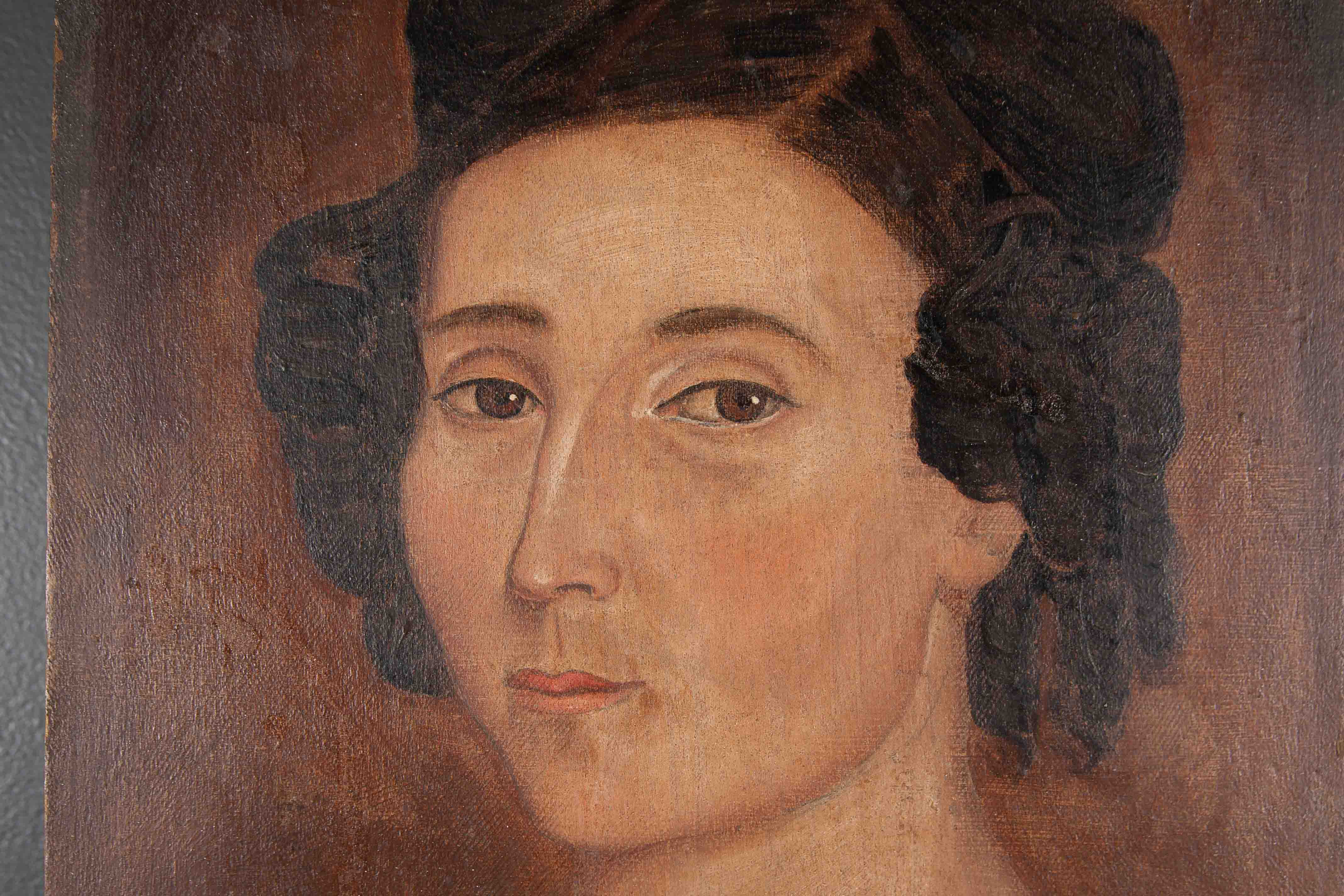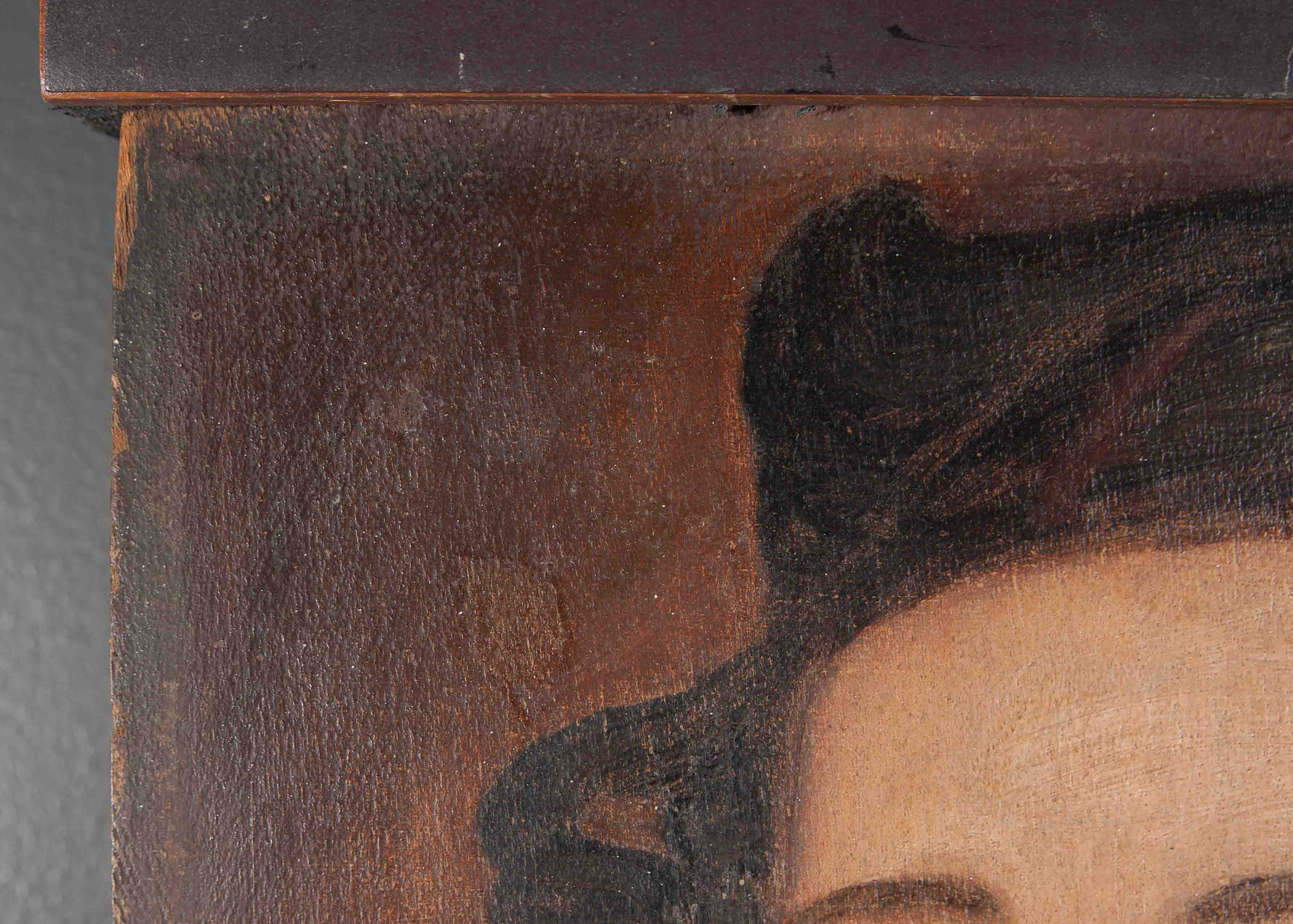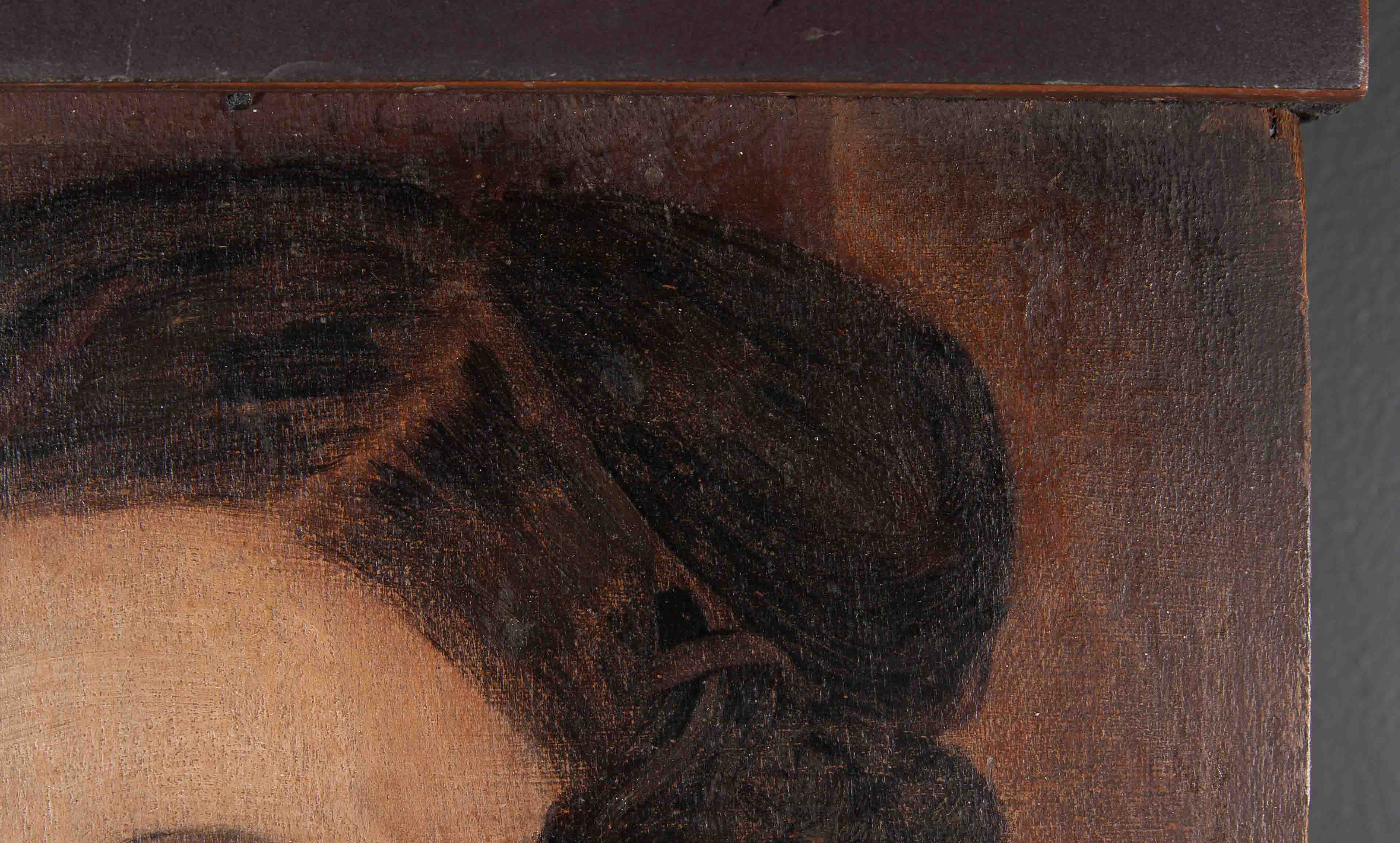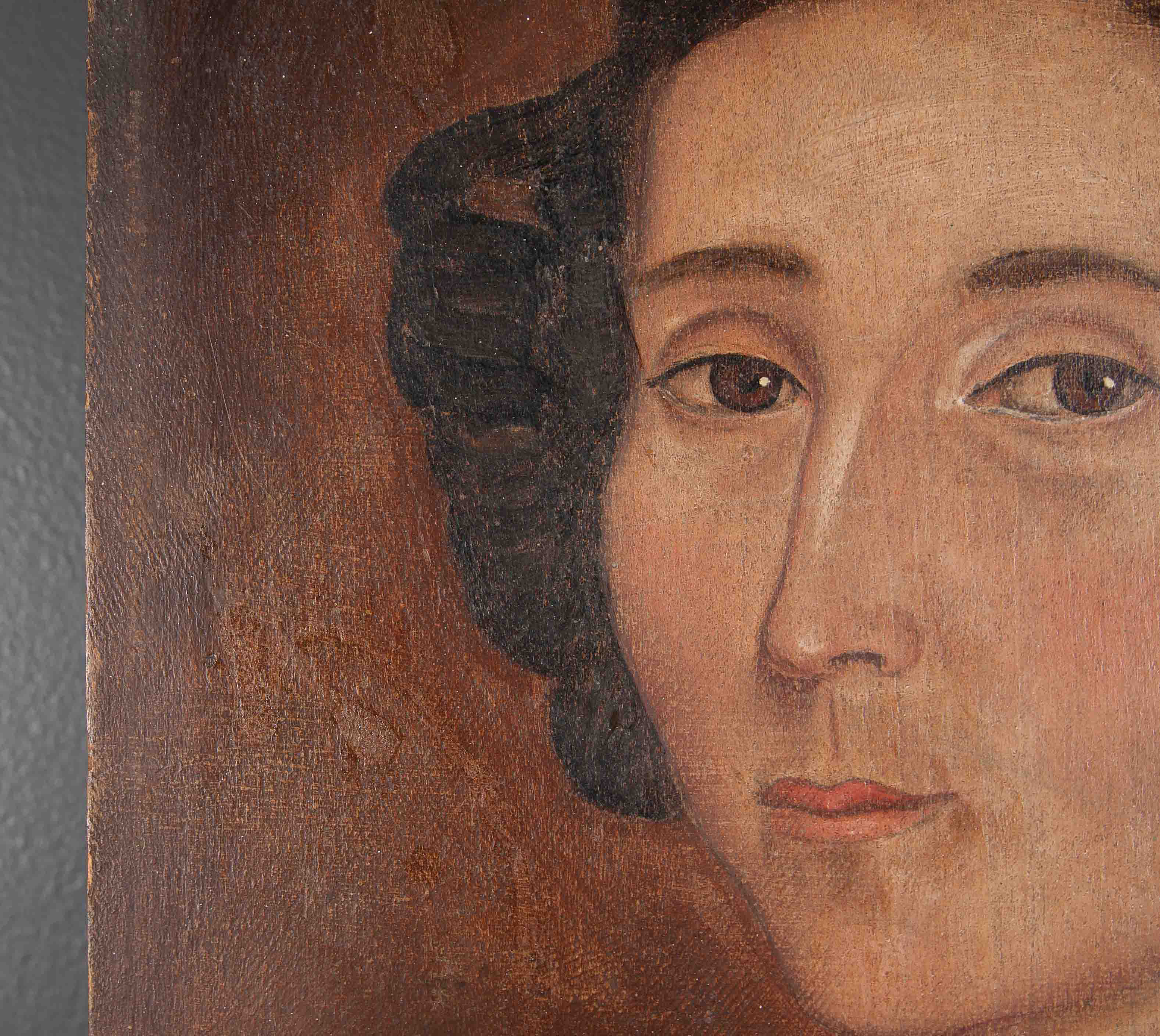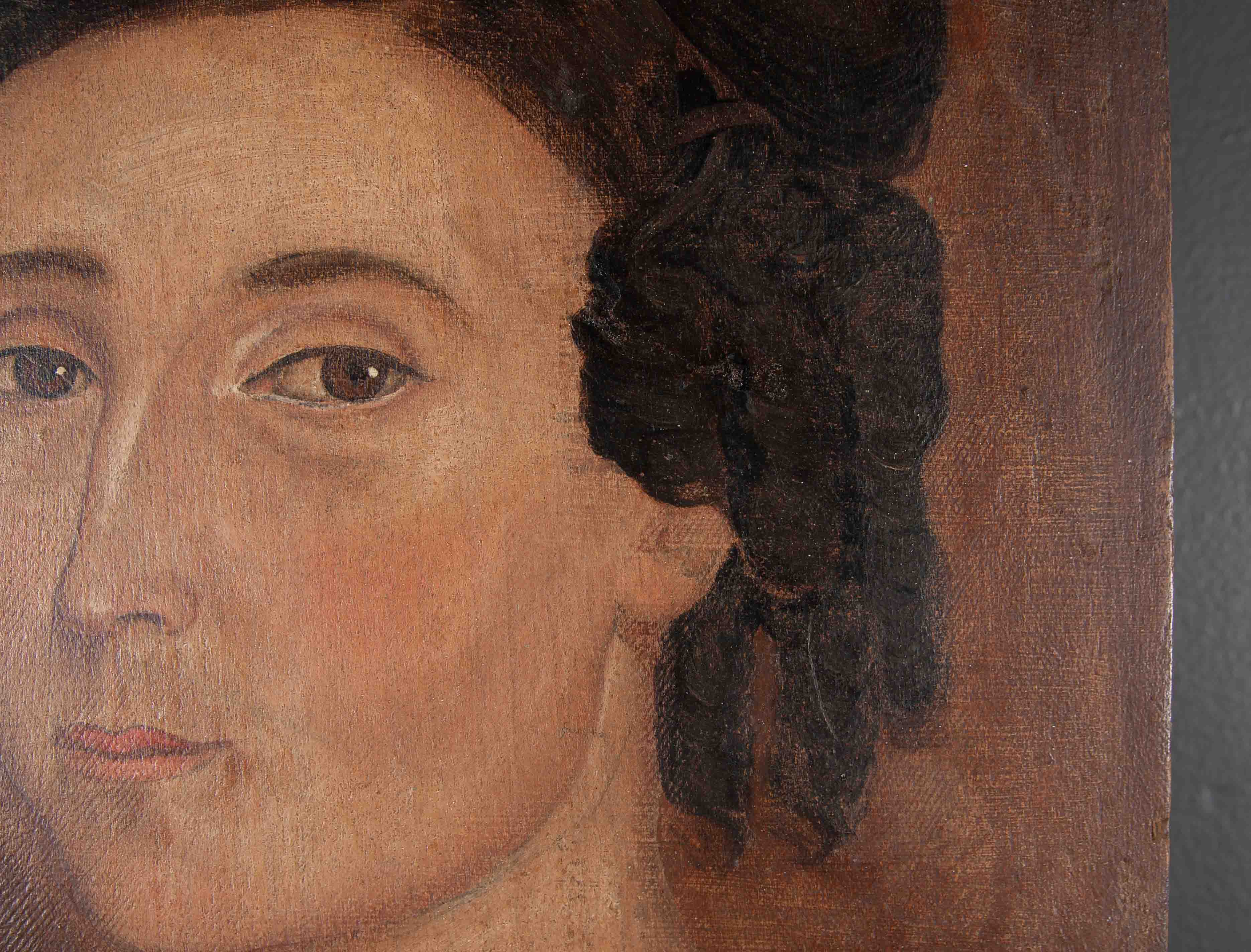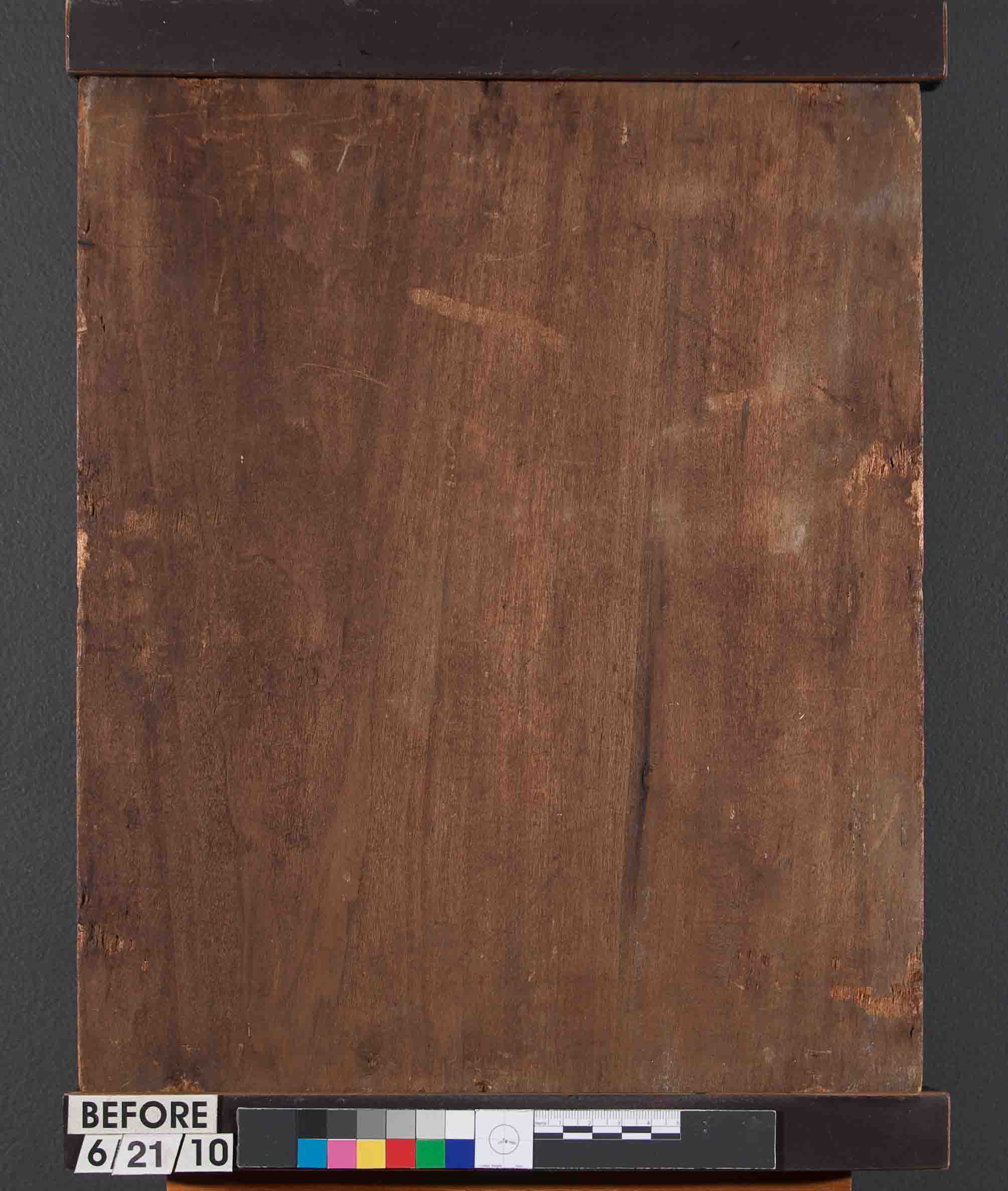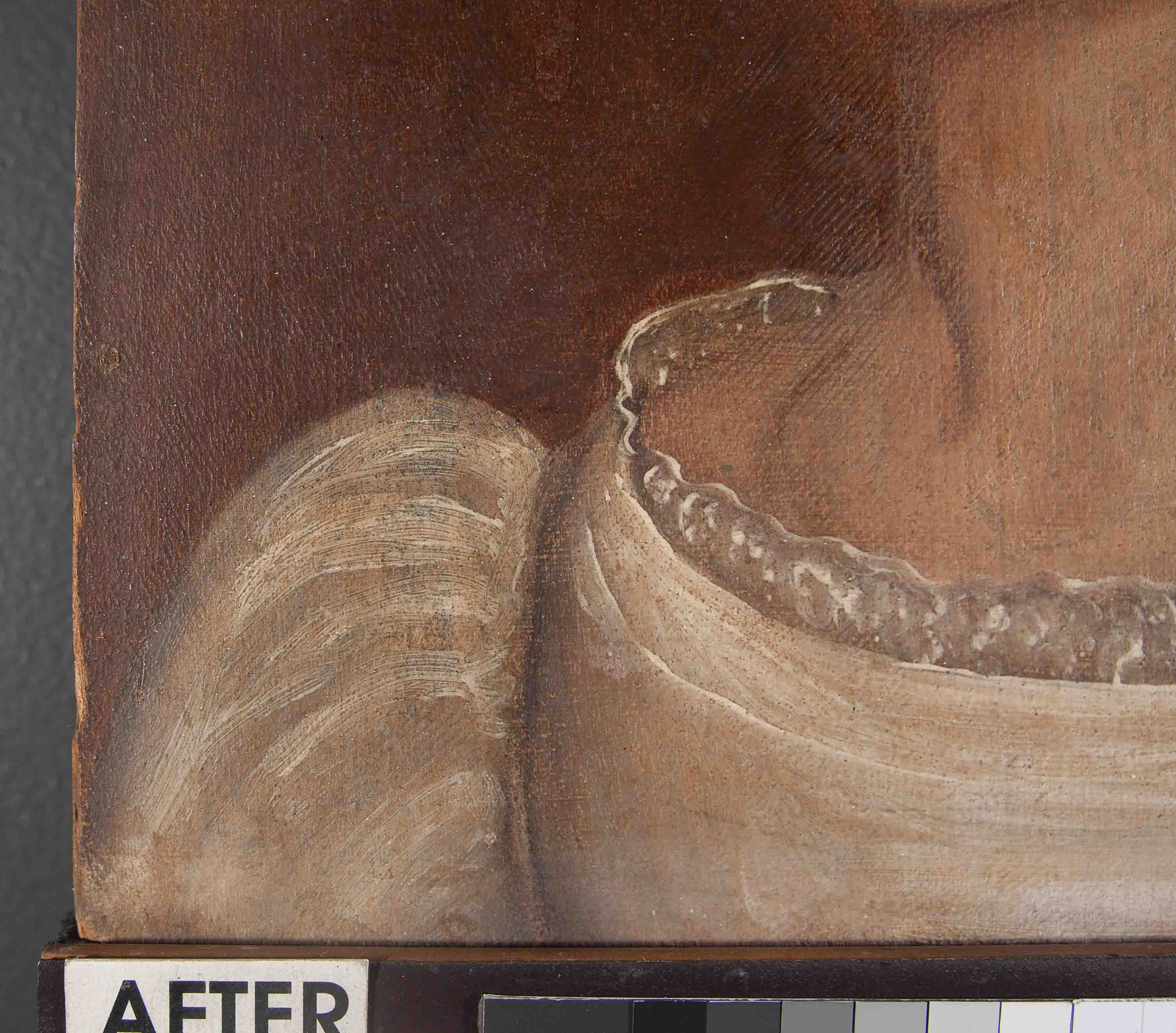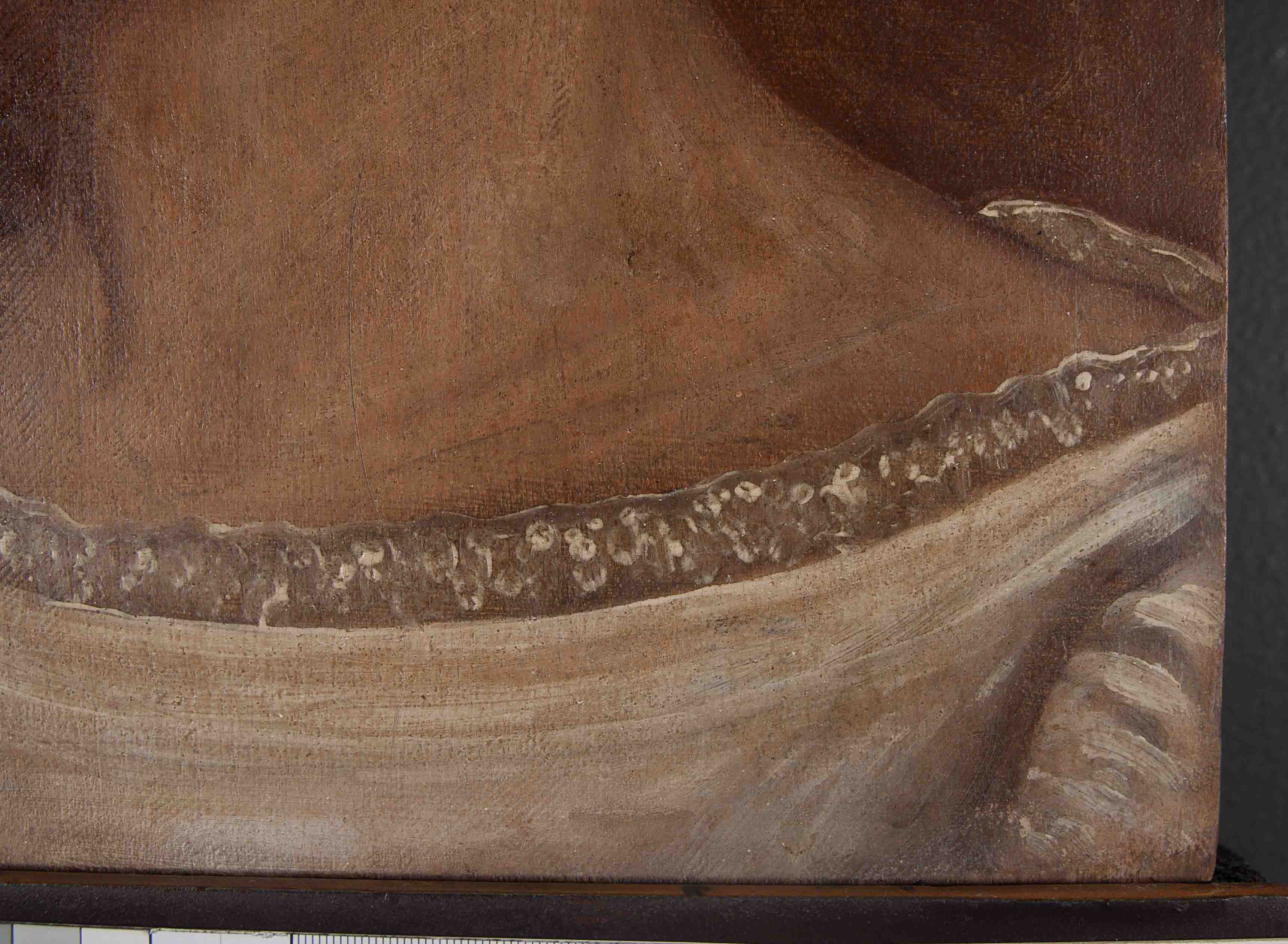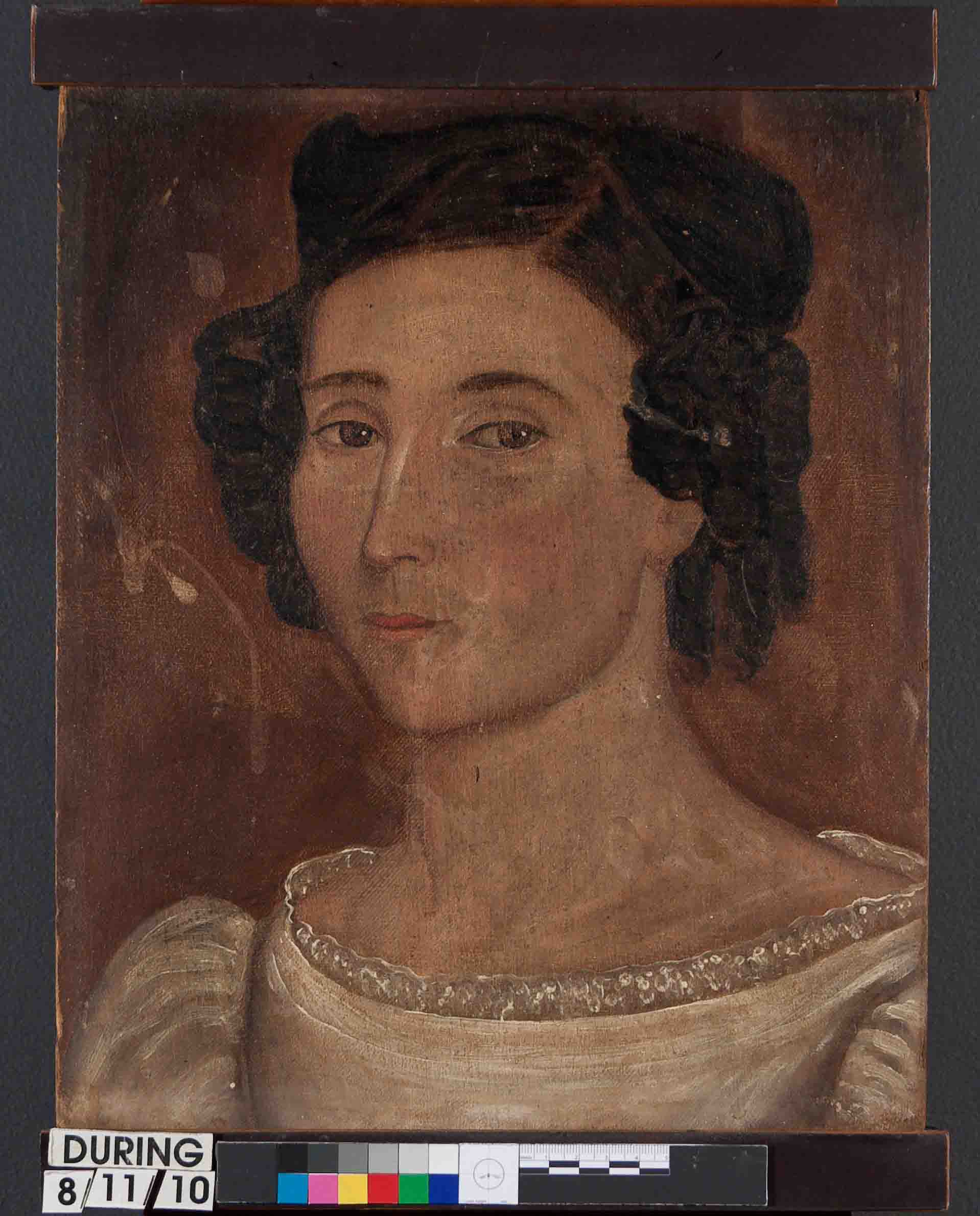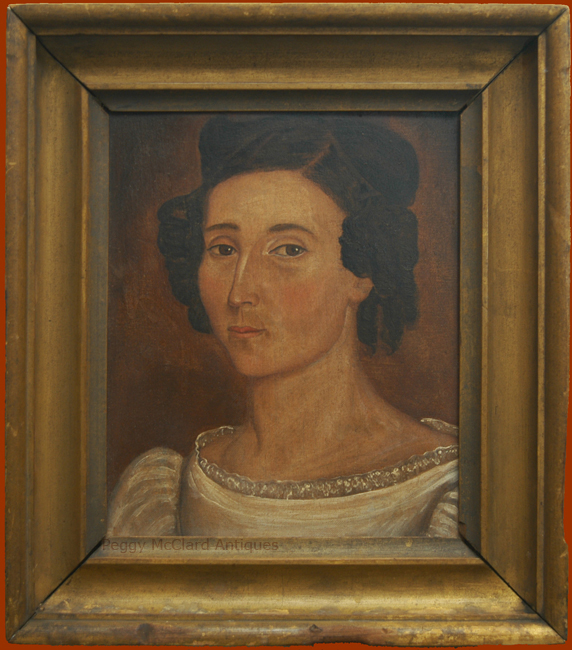
This is a fabulous American folk portrait, new to the market, and great by any standards. I'm attributing this beautiful lady to American artist Sheldon Peck for the reasons below. I will say that one other person knowledgeable about Peck's worked disagrees with my attribution....those reasons are given below also. After much consideration, I am sticking with my attribution because I believe that this oil portrait on wood panel is an example of Peck's early work, while still in Vermont and while developing his skills.
Sheldon Peck was born in Cornwall, Vermont in 1797. He was a self-taught itinerant portrait artist who never signed his work. His earliest portraits, painted in Vermont, appear to be executed according to a formula worked out in an attempt to catch a likeness in a brief period of time. During this time, Peck elaborated on his sitters' coiffures and dress by painting curls, lace-trimmed collars and bonnets, and gold buttons. A decorative motif that reappears throughout the artist's career is a series of brushstrokes often called a rabbit's foot--a long stroke, flanked by two shorter ones. Peck used this decorative motif in the elaboration of lace and other decorative elements of the sitter's clothing. By 1828, Peck and his family had moved to New York. During his New York Period, Peck executed half and three-quarter length portraits on wood panels as he had done in Vermont. However, his New York palette was brighter and the portraits more detailed in their execution. These large portraits were often embellished with draperies, painted furniture and other accessories. Sometime after 1836, the Pecks moved to Chicago. Peck's Chicago Period seemed a return to his simple Vermont style so that in an era of financial depression, he could reduce his prices. The Chicago portraits are painted on canvas which was probably more accessible to him and certainly took much less time to prepare than did his wood panels.
Besides Peck's signature rabbit's foot brush stroke, his sitters can be identified by several details: (1) The sitters always engage the viewer by looking directly forward from the corner of their eyes; (2) the face modeling of the sitters is strong to the point of almost being severe with very angular facial features, especially the nose; (3) women sitters often had their elaborate coiffure held by a low flat topped comb (although very high combs were the current fashion during much of the period in which he painted); (4) Peck scored his wood panels so that they have a textural look of canvas; (5) Peck applied his paint directly to the wood panels very thinly.
So, the characteristics that scream Sheldon Peck to me in this portrait of this beautiful woman are as follows: 1) The hairstyle is so very precise and very similar to the hairstyles in many of Peck's portraits of women. The hairstyle and the low flat comb are the same style and painting technique used in Peck's "Portrait of a Young Woman Holding a Book" sold by Northeast Auctions in 2009 and "Portrait of Miss Palmer of Gloversville" sold at Sotheby's New York in 1987. 2) The strong facial modeling and the severe features, including the nose are very much in keeping with Peck's work, especially comparable to "Portrait of blue-eyed man with yellow vest" sold at Northeast Auctions in 2005. 3) Although this lady's ear is mostly covered, the ear lobe is also in keeping with Peck's work, especially visible in the blue-eyed man described above. 4) The brown paint used in the background and the treatment of that paint was often used in his Vermont work and even later, including "Portrait of Sally Adams", offered by Sotheby's New York 2005; "Portrait of Dark-Haired, Blue-Eyed Gentleman", sold Sotheby's New York, 2005; "Portrait of a Boy in a Green Suit", sold Sotheby's New York, 2004. 5) The wood panel is scored to give the textural impression of canvas. 6) The oil paint is very thinly directly applied to the wood.
These are the concerns I have about the attribution (which are also the reasons the other Peck authority disagrees with the attribution): 1) There are no recorded Peck bust-length portraits (all are half or three-quarter length). 2) The rabbit's foot brushstroke is not present in this portrait. 3) There are no recorded Peck portraits in which the sitter fills so much of the space (i.e. he had more background with the sitter farther back in the wood panel). 4) This lady's dress is not as elaborate as one expects from Peck.
So, there. You have both sides of the attribution story. My view is that this is an early work by a self-taught artist who was developing his style. He worked as an itinerant artist and carrying large wood panels was always a hardship for itinerant artists. It makes sense to me that he would have also carried smaller panels to lighten his load and allow him to present another pricing option for clients (bust-length portraits greatly discounted from their half-length cousins). The likelihood that he created the rabbit's foot signature brushstroke from his first commissioned works is nil in my view. The lacework on this lady's dress is not as elaborate as later works, but that again could go to a developing artist.....or perhaps this lady liked a simpler style. It is important to remember that an attribution is an educated guess, made by someone who has some expertise in the field. Attributions should not be made by people who have not studied the artist but also remember that attributions can be wrong, no matter how important the attributor is in the field. I would not call my opinion an "attribution" if I did not feel very strongly that this work was done by Peck. However, I have listed all of the reasons backing and disagreeing with the attribution so that you can be the judge, or you can bring in another authority to give her opinion.
The painting came to me after passing through a small auction house in the Midwest--totally unattributed and in untouched condition. The frame is original and has some scarring around the edges as you can see in the photo. Some caustic liquid had dripped on the painting and it was covered in grime. The last photo in this listing shows the condition of the painting before I had the great conservators at Whitten & Proctor conserve the painting. They judiciously cleaned the painting and then filled a few spots where the caustic liquid had eaten through to the wood and did a small amount of reversible inpainting. I'm happy to send you a copy of the conservation report and my goal is to set up a system where I can take a photo of the portrait under blacklight. Please bear with me on this -- I'll post the blacklight photo as soon as I can get the process figured out and have something to show you. I'm also happy to send you larger format photos of the piece. The wood panel is in very good condition, with the tiniest warp in the upper left corner.....you really can't see it without taking the panel out of the frame and laying it on a table.....it fits the frame perfectly. The first photo of the framed portrait is taken by me and most true to life in color and finish. The conservator photos below show you great detail but are taken with spot lights and make the portrait appear brighter and shinier than it is. The conservator rubbed a blend of greatly thinned varnish and wax into the portrait so it has the mat finish that it originally had (this finish is also reversible).
This is a wonderful American folk portrait, whether you accept the Peck attribution or not. Framed size is 17" x 19 1/4". Size of the wood panel is 11 5/8" x 14"
(#4725) Price on Request
Please see the Folk Portrait Artists page for more information about Sheldon Peck.

